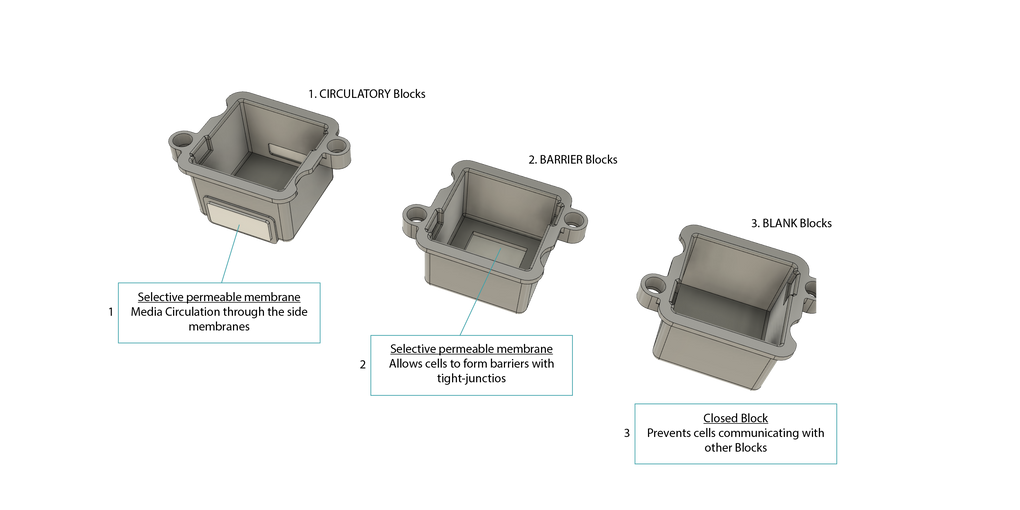CELLBLOKS®, is a multi-organ/cell type modular “plug and play” co-culture technology. It serves the purpose of emulating the organ microenvironment in a standardin-vitrosetting. It provides the feasibility of studying the assays in 2-D, 3-D cell growth condition, and in static or flow system, by using a standard perfusion rocker. Using CELLBLOKS® different cell types can be grown on Barrier Blocks™ or Circulatory Blocks™that emulate barrier organs or those in systematic circulation. Blocks containing organ specific cells can then be connected to each other in variety of ways to simulate complex organ-organ interactions. For instance, Intestinal cell are grown on Barrier Blocks, whereas Liver and lung cells in Circulatory Blocks.In this way you can quickly and easy set up an experiment in the lab to simulate complex body conditions, for example, to test how organs communicate to each other when they are exposed to a test drug
How does it work
THE PLATFORM
Cell-cell communication studies made easy
CELLBLOKS® platform has dimensions of a SBS standard Tissue Culture well plate. It has four sperate elongated channels with location for three separate Blocks. Each channel is filled with media (3-5 ml) to allow the cell-cell communication between the Blocks

THE CELL GROWTH BLOCKS
Achieve better representation of different Organtype communications
1. Circulatory Blocks™ provide a flat plastic surface for cells to grow with side circulatory windows on the walls allowing selective media diffusion (both inlet and outlet, simulating organs in systematic circulation e.g. liver, brain, heart, lung).
2. Barrier Blocks™ contain a selective permeable membrane on the bottom of the Block, allowing cell to proliferative on basolateral membrane (simulating epithelial cells and tissues).
3. Blank Blocks™ have the same flat surface as the Circulatory Blocks for cell growth but no inlet or outlet for media diffusion. Blank Blocks are used to isolate cell cultures from other compartments and are often used as controls.

FILTERED AIR FLOW
Better ways to reduce contamination, media evaporation and avoid pH drifts
The CELLBLOKS® chamber comes with new design Clip-Closure "Air-Lid" feature with two side clips that make it easy to create 100% hermetic seal around the chamber. PTFE air filters and an o-ring seal have been incorporated in the lid in order to filter the air reaching cell cultures. Gas is in cultures is only exchanged through selectively permeable air filters (0.2 micorn) which reduce potential contamination of cells, evaporation of media, and fluctuations of pH during experimentation. In contrast to other cell culure platforms the Air-Lid technology is first-of-its-kind - enabling more reproducible data acqusitions and handling advantages.

Cross-talk between cell made easy

Some applications of CELLBLOKS
Case Study
Modelling multiple cell type liver architype for drug induced liver injury (DILI) screening using CELLBLOKS®
Other examples
ADME profiling set-up example
The example below shows how an intestine-hepatic model can be simulated in the CELLBLOKS® by using the Customised Kit platform to study the absorption, distribution and metabolism (ADME) of a drug or chemical as well as its effect on a target organ. Briefly, the Intestinal layer is modelled by growing CaCo-2 cells, for example, on Barrier Blocks that allows absorption of the drug. After absorption through the intestinal epithelium, the drug diffuses and is distributed into the channels (containing media) and to latter Blocks containing separate liver and lung compartments. The liver cells in the latter Circulatory Block metabolises the drug and the third compartment (lung) is used as a target organ. CELLBLOKS® can be used to set-up a tri-organ co-culture experiment and determine the effect of each compartment on the interaction between them. This is achieved in ONE PLATFOM by using combination of Barrier, Circulatory and Blank Blocks. As illustrated below, 12 Blocks are needed in total and they arranged in combinations of 3s, 2s and isolated blanks.







